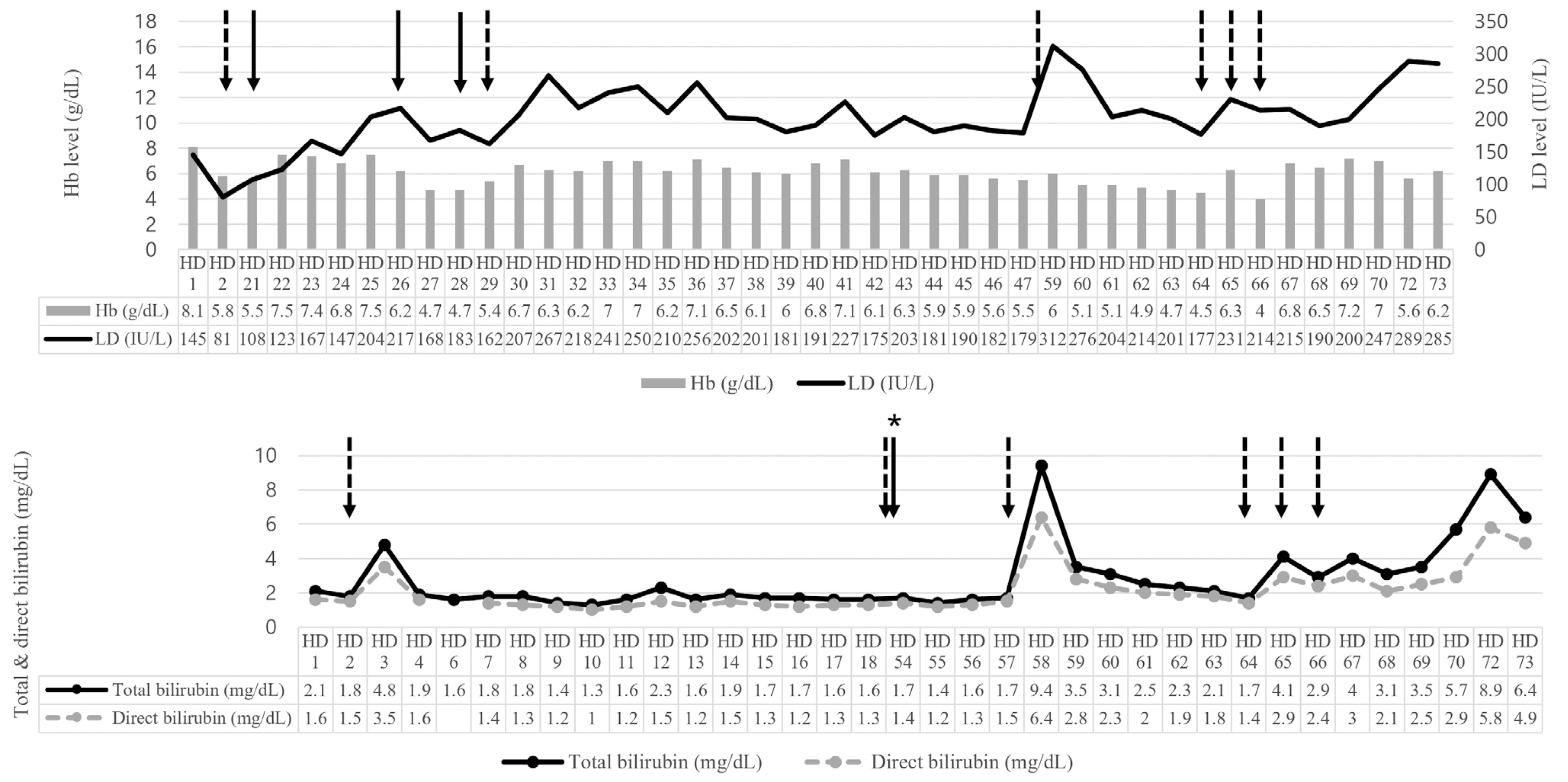Lab Med Online.
2022 Jul;12(3):205-208. 10.47429/lmo.2022.12.3.205.
Transfusion of the Least-incompatible Blood with Intravenous Immunoglobulin and Steroid to a Patient with Anti-Fya
- Affiliations
-
- 1Department of Laboratory Medicine, Asan Medical Center, University of Ulsan College of Medicine, Seoul, Korea
- 2Department of Laboratory Medicine, Kangdong Sacred Heart Hospital, Seoul, Korea
- 3Department of Laboratory Medicine, Seoul National University Hospital, Seoul, Korea
- KMID: 2538607
- DOI: http://doi.org/10.47429/lmo.2022.12.3.205
Abstract
- Antibody to high-incidence antigens is one of the most challenging issues in transfusion medicine. Transfusion of the least-incompatible red blood cell (RBC) unit is standard practice, which may sometimes result in unfavorable outcomes. In this case, we attempted to transfuse the least-incompatible blood with intravenous immunoglobulin (IVIG) and steroid to a patient with anti-Fya. A 39-year-old female patient with liver cirrhosis was admitted for nausea and vomiting. Her hemoglobin level was 5.5 g/dL. Antibody identification tests showed anti-E, c, Jkb, and Fya alloantibodies. As Fya is a high-incidence antigen in Korea, she was transfused with 8 least-incompatible RBC units containing the Fya antigen in conjunction with IVIG and methylprednisolone. Although evidence of mild hemolysis was found in laboratory tests, there were no significant side effects. To the best of our knowledge, this is the first report of a transfusion strategy for a patient with anti-Fya.
Keyword
Figure
Reference
-
1. Choi SJ, Chung YN, Cho D, Kim S. 2019; Alloantibodies to high-incidence antigen: review of cases and transfusion experiences in Korea. Korean J Blood Transfus. 30:101–12. DOI: 10.17945/kjbt.2019.30.2.101.
Article2. Choi SJ, Nah H, Kim Y, Kim S, Kim HO. 2018; Case of acute hemolytic transfusion reaction due to anti-Fya alloantibody in a patient with autoimmune hemolytic anemia. Korean J Blood Transfus. 29:320–7. DOI: 10.17945/kjbt.2018.29.3.320.
Article3. Park TS, Chang CL, Chung JS, Cho H, Lee EY, Son HC, et al. 2005; The frequency and clinical significance of delayed serological transfusion reactions in Korean population. Korean J Blood Transfus. 16:20–31.4. Lee WH, Kim SY, Kim HO. 2000; The incidence of unexpected antibodies in transfusion candidates. Korean J Blood Transfus. 11:99–103.5. Song DH, Moon IS, Hong SJ, Park JH, Kim JG, Jeon DS. 1998; Frequency and distribution of unexpected antibodies of Koreans. Korean J Blood Trans-fus. 9:191–200.6. Moore SB, Taswell HF, Pineda AA, Sonnenberg CL. 1980; Delayed hemolytic transfusion reactions. Evidence of the need for an improved pretransfusion compatibility test. Am J Clin Pathol. 74:94–7. DOI: 10.1093/ajcp/74.1.94. PMID: 7395821.
Article7. Han KS, Oh WI, Park MH, Kim EJ, Kim SI. 1989; Irregular blood group antibodies in Korean. Korean J Hematol. 24:145–53.8. Han KS, Park KU, Song EY. 2014. Transfusion medicine. 4th ed. Seoul: Korea Medical Book Publishing Company;p. 210–23.9. Kim S, Hur M, Lee KM, Chun W. 2009; A case of delayed hemolytic transfusion reaction in a patient with anti-c, anti-E, and anti-Jkb. Korean J Blood Transfus. 20:144–50.10. Lim CS, Kim YK, Lee KN. 2007; The Duffy blood group genotypes in Asian populations. Korean J Blood Transfus. 18:145–51.11. Oh DJ, Kim MJ, Seo DH, Song EY, Han KS, Kim HO. 2003; The frequency of unexpected antibodies in blood donors and transfusion candidates in Korea. Korean J Blood Transfus. 14:160–72.12. Win N. Guidelines for the management of urgent red cell transfusion and situations when serological compatibility cannot be assured. INF437/4. https://nhsbtdbe.blob.core.windows.net/umbraco-assets-corp/17059/inf4374-guidelines-for-the-management-of-urgent-red-cell-transfusion-and-situations-when-serological-compatibility-cannot-be-assured.pdf. Updated on Oct 2019.13. Win N, Almusawy M, Fitzgerald L, Hannah G, Bullock T. 2019; Prevention of hemolytic transfusion reactions with intravenous immunoglobulin prophylaxis in U-patients with anti-U. Transfusion. 59:1916–20. DOI: 10.1111/trf.15230. PMID: 30861151.
Article14. Win N, Needs M, Thornton N, Webster R, Chang C. 2018; Transfusions of least-incompatible blood with intravenous immunoglobulin plus steroids cover in two patients with rare antibody. Transfusion. 58:1626–30. DOI: 10.1111/trf.14648. PMID: 29732576.
Article15. Lee HJ, Shin KH, Kim H, Jeong S, Kong SG, Kim HH. 2018; A case of sickle cell anemia with a lack of high frequency red blood cell antigen. Korean J Blood Transfus. 29:188–93. DOI: 10.17945/kjbt.2018.29.2.188.
Article
- Full Text Links
- Actions
-
Cited
- CITED
-
- Close
- Share
- Similar articles
-
- ABO/RhD-Mismatch Transfusion
- Case of Acute Hemolytic Transfusion Reaction due to Anti-Fy(a) Alloantibody in a Patient with Autoimmune Hemolytic Anemia
- Effect of the Least Incompatible Blood Transfusion in Patients with Panagglutination (Least Incompatible Blood Transfusion)
- Acute Hemolysis Due to Rh Antibodies Against C and e Antigens after Rh-incompatible Transfusion in a Patient, Not Detected During Pre-transfusion Testing
- Alleles for Associated with Fy(a), Fy(b), Fy(x) and Fy Antigens in a Korean Population


